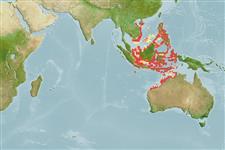>
Eupercaria/misc (Various families in series Eupercaria) >
Nemipteridae (Threadfin breams, Whiptail breams)
Etymology: Pentapodus: Greek, pente = five + Greek, pous = feet (Ref. 45335).
Eponymy: James Barker Emery (ca: 1794–1889) was a gifted artist and amateur naturalist who joined the Royal Navy (1808) and was First Lieutenant aboard the ‘Beagle’ during a survey of the Australian coast (1837–1841). [...] (Ref. 128868), visit book page.
More on author: Richardson.
Environment: milieu / climate zone / depth range / distribution range
Ecología
marino asociado a arrecife; rango de profundidad 2 - 35 m (Ref. 90102). Tropical; 19°N - 23°S, 104°E - 131°E (Ref. 3810)
Western Pacific: Philippines, Indonesia, and northwestern Australia.
Tamaño / Peso / Age
Maturity: Lm ? range ? - ? cm
Max length : 35.0 cm TL macho / no sexado; (Ref. 90102); common length : 18.0 cm SL macho / no sexado; (Ref. 3810)
Espinas dorsales (total) : 10; Radios blandos dorsales (total) : 9; Espinas anales: 3; Radios blandos anales: 7. Head scales reaching forward to level of posterior nostrils. Suborbital naked. Lower limb of preopercle with 2 or 3 scale rows. Pelvic fins moderately long, reaching almost to level of anus. Axillary scale present. Color: Upper body blue, lower white.
Found on clear coastal reef slopes (Ref. 48635). A solitary species (Ref. 9710) but may be found also in groups (Ref. 90102). Excellent eye-sight (Ref. 48635). Feeds on small fishes, crustaceans, ophiuroids and sipunculid worms.
Life cycle and mating behavior
Madurez | Reproducción | Puesta | Huevos | Fecundidad | Larva
Russell, B.C., 1990. FAO Species Catalogue. Vol. 12. Nemipterid fishes of the world. (Threadfin breams, whiptail breams, monocle breams, dwarf monocle breams, and coral breams). Family Nemipteridae. An annotated and illustrated catalogue of nemipterid species known to date. FAO Fish. Synop. 125(12):149p. Rome: FAO. (Ref. 3810)
IUCN Red List Status (Ref. 130435: Version 2024-1)
Threat to humans
Harmless
Human uses
Pesquerías: pesquerías de subsistencia
Herramientas
Special reports
Download XML
Fuentes de Internet
Estimates based on models
Preferred temperature (Ref.
123201): 27.2 - 29.1, mean 28.7 °C (based on 1099 cells).
Phylogenetic diversity index (Ref.
82804): PD
50 = 0.5002 [Uniqueness, from 0.5 = low to 2.0 = high].
Bayesian length-weight: a=0.01445 (0.00683 - 0.03057), b=2.98 (2.81 - 3.15), in cm total length, based on LWR estimates for this (Sub)family-body shape (Ref.
93245).
Nivel trófico (Ref.
69278): 3.6 ±0.50 se; based on food items.
Resiliencia (Ref.
120179): Medio, población duplicada en un tiempo mínimo de 1.4-4.4 años (Preliminary K or Fecundity.).
Fishing Vulnerability (Ref.
59153): Low vulnerability (25 of 100).
Nutrients (Ref.
124155): Calcium = 49.2 [31.0, 97.9] mg/100g; Iron = 0.613 [0.302, 1.522] mg/100g; Protein = 19.1 [17.2, 20.8] %; Omega3 = 0.142 [0.087, 0.236] g/100g; Selenium = 29.1 [17.4, 51.3] μg/100g; VitaminA = 71 [21, 200] μg/100g; Zinc = 1.18 [0.83, 1.69] mg/100g (wet weight);
